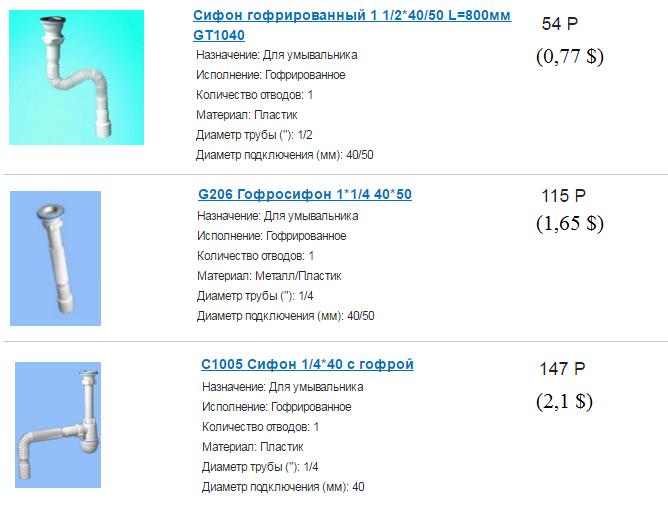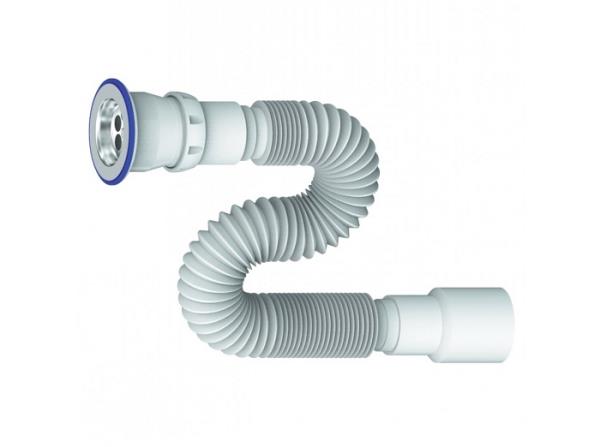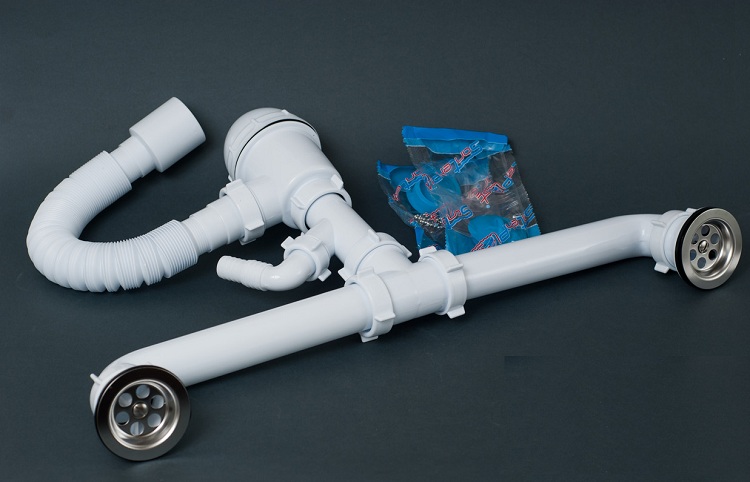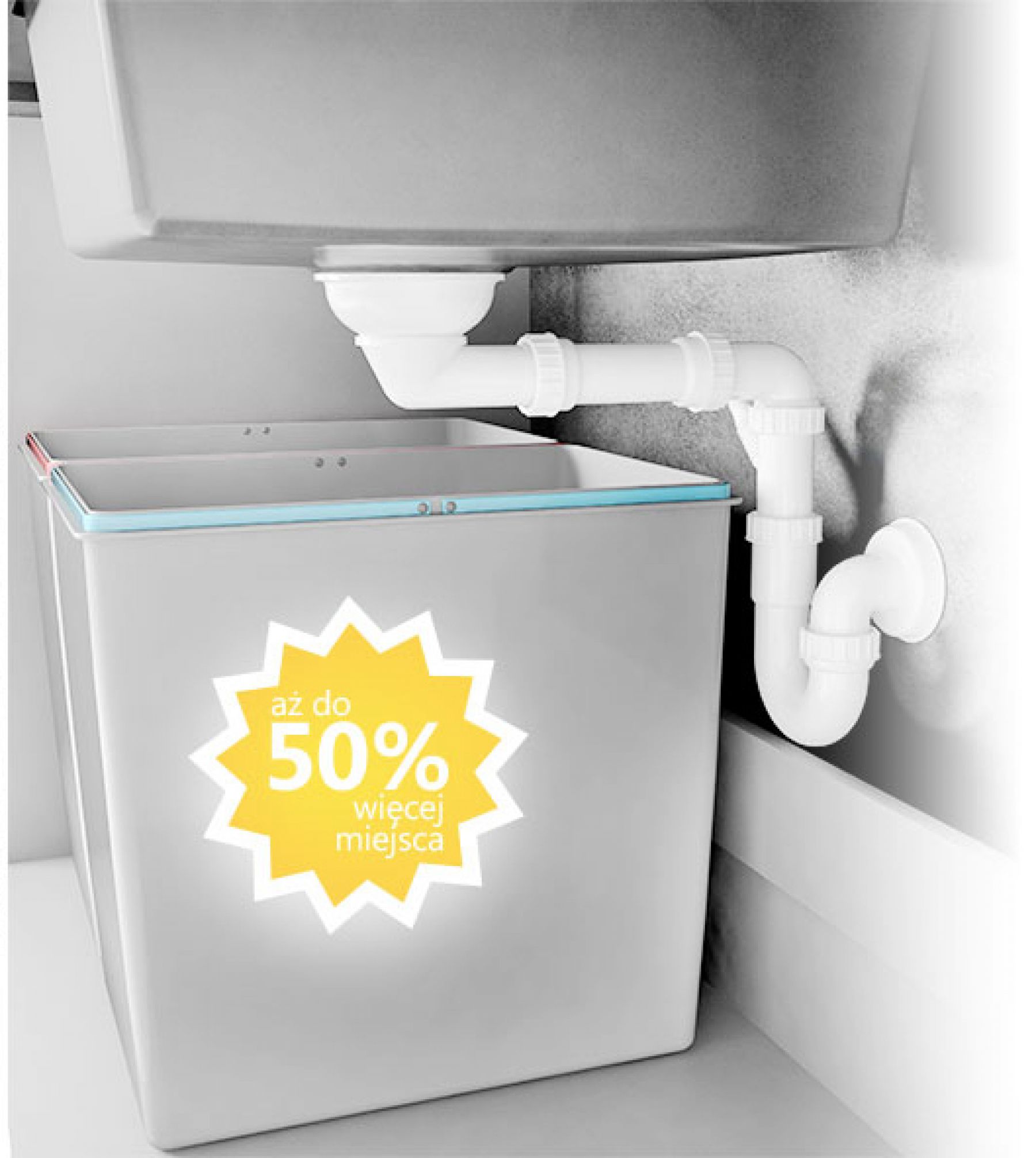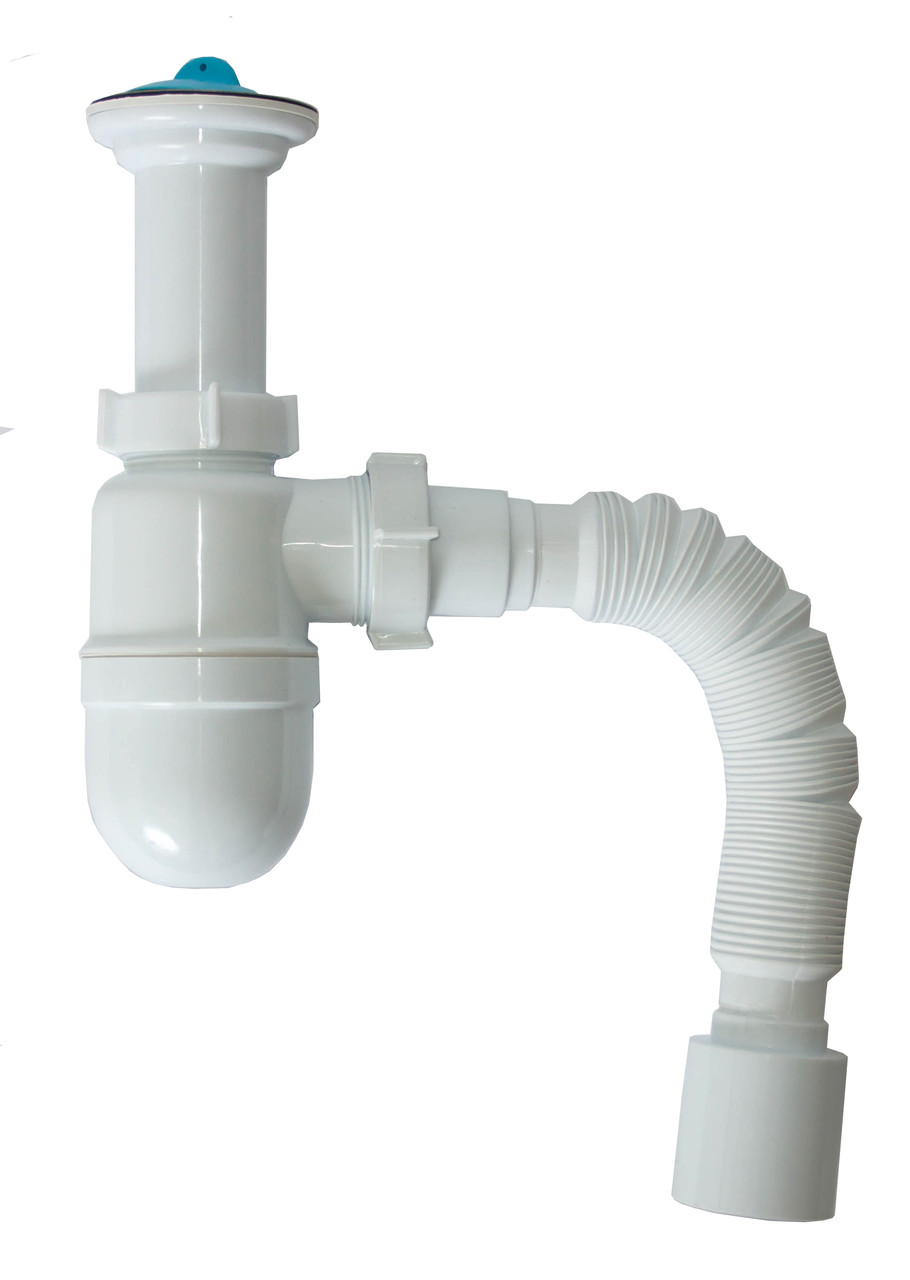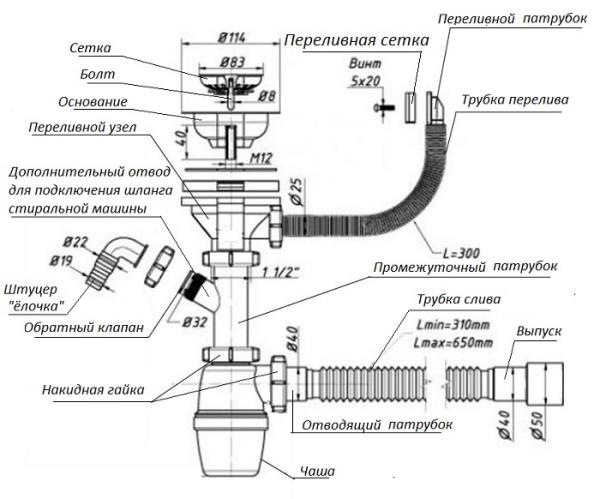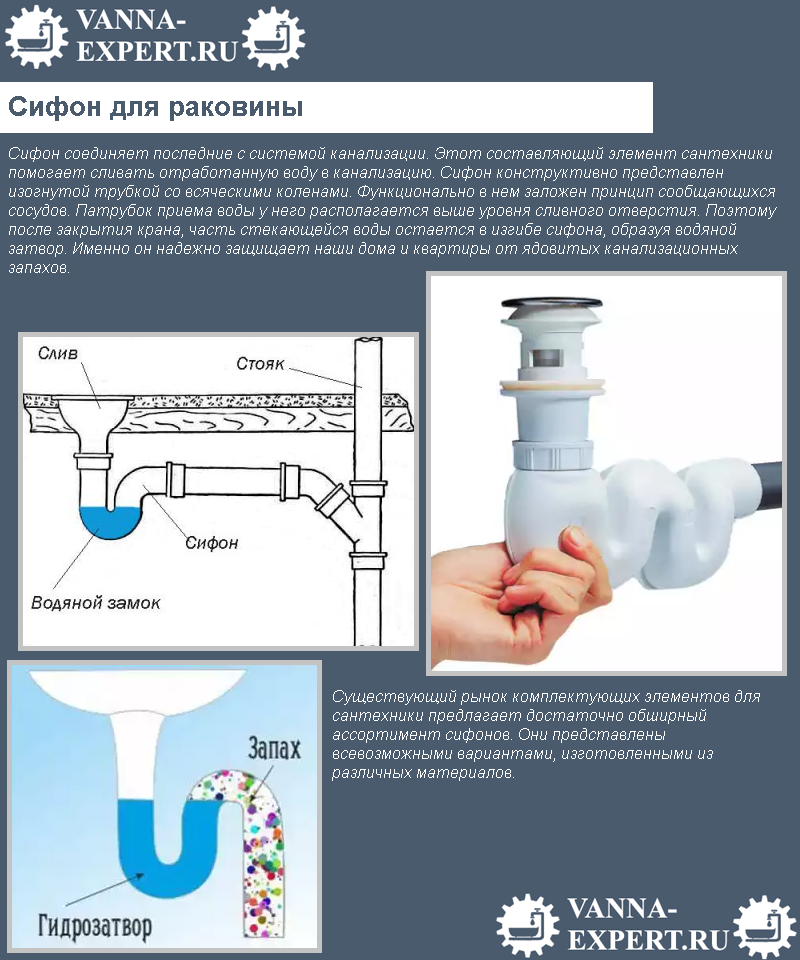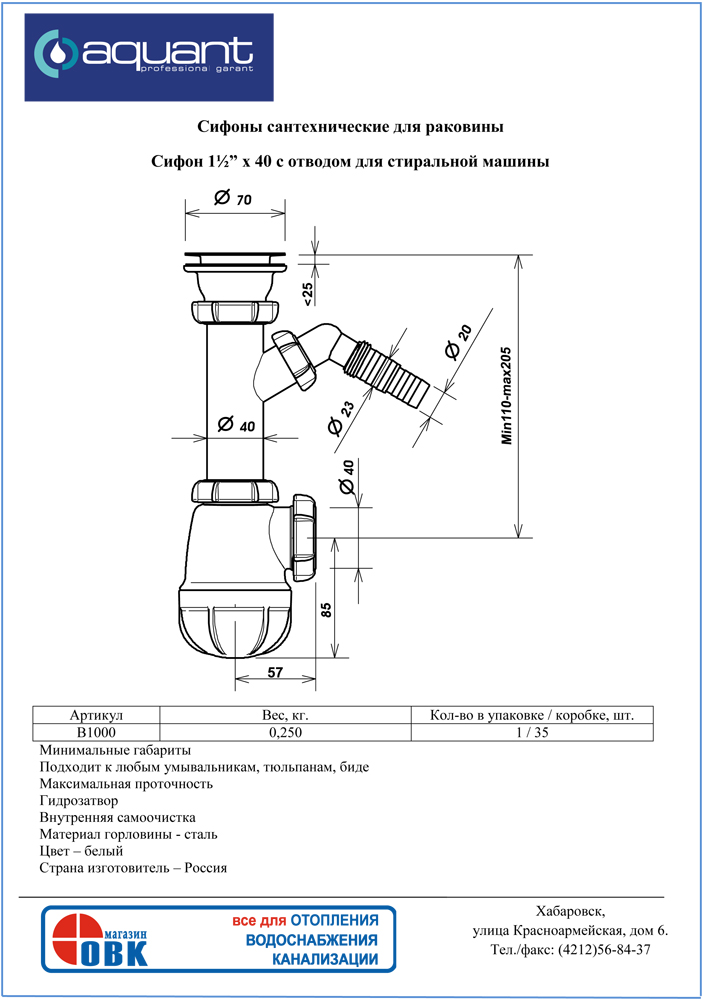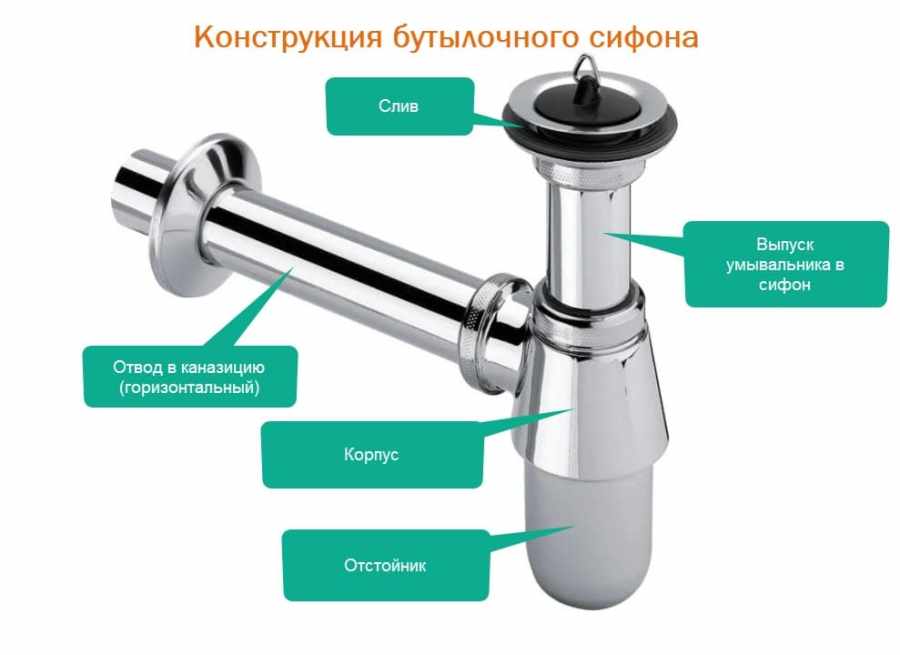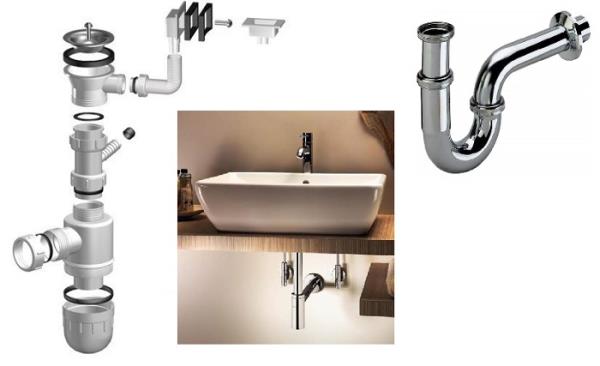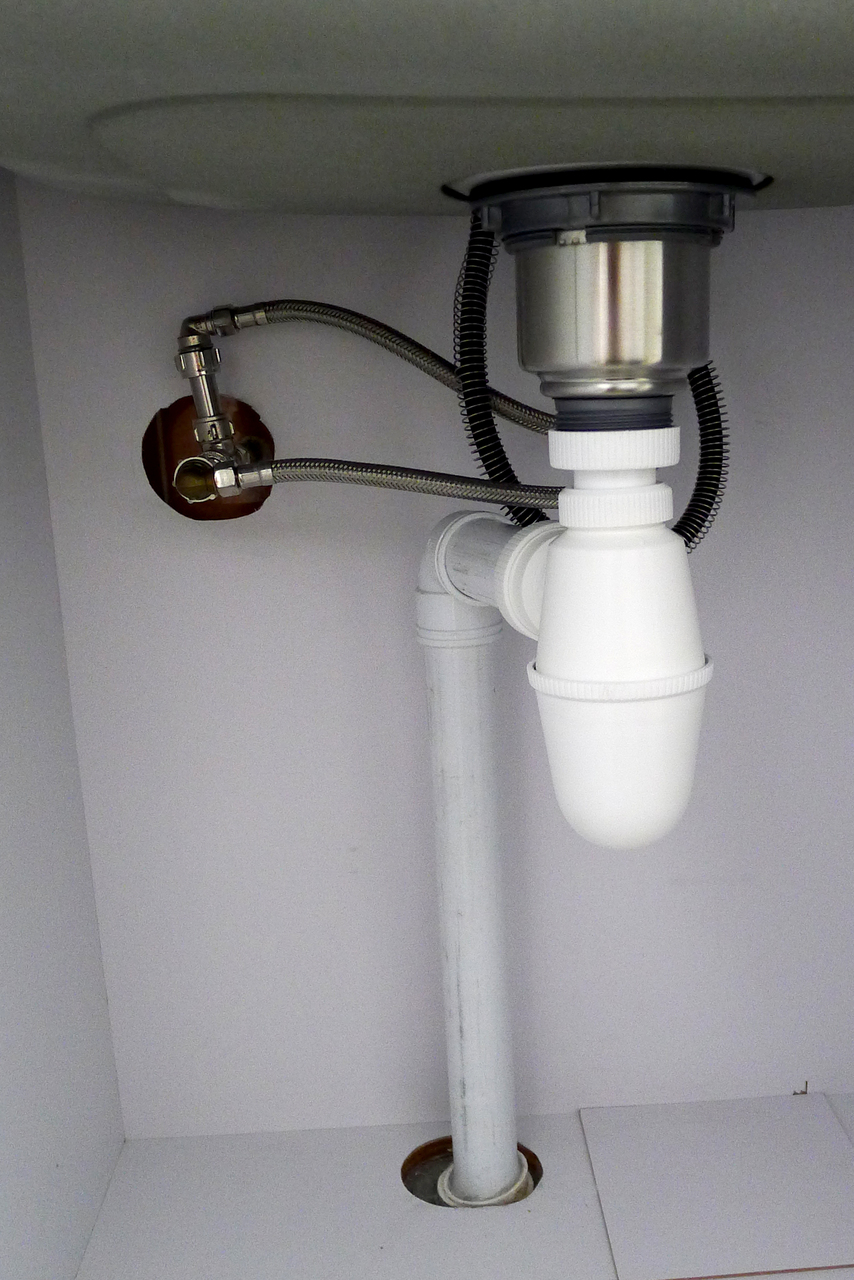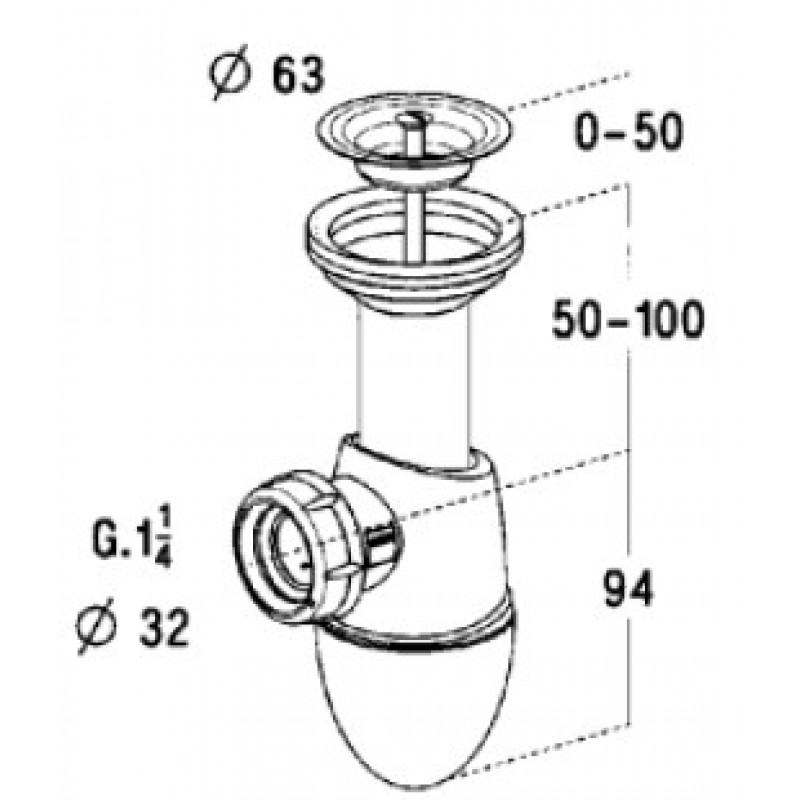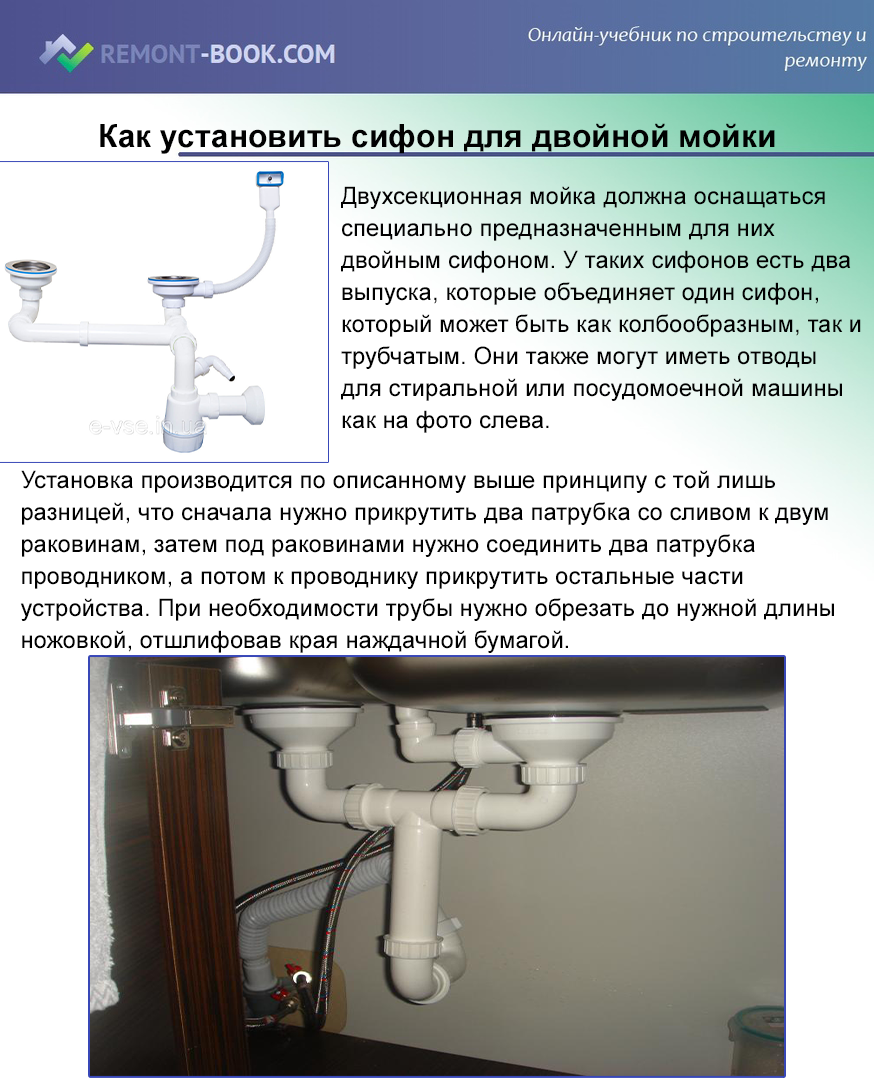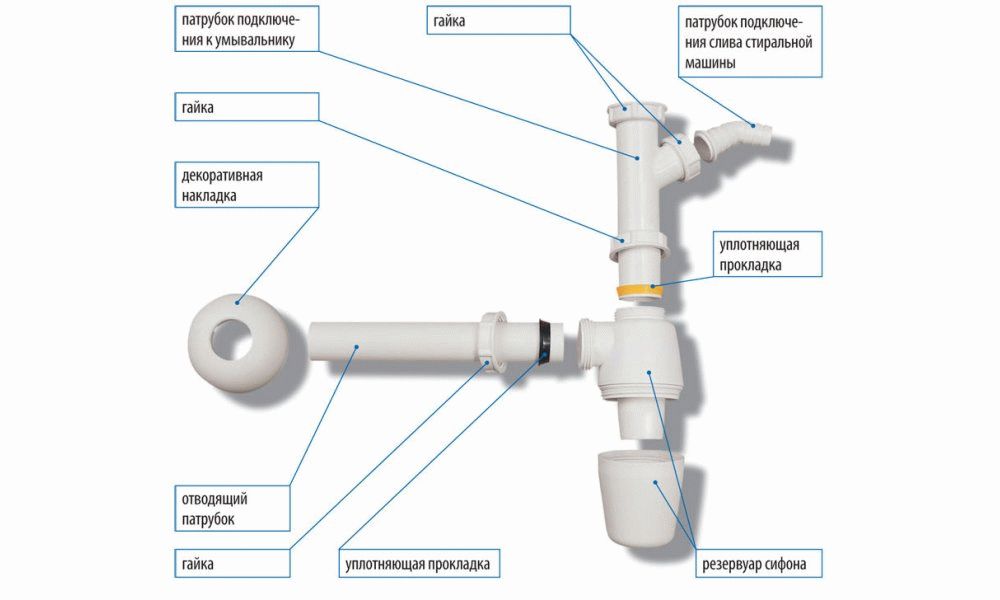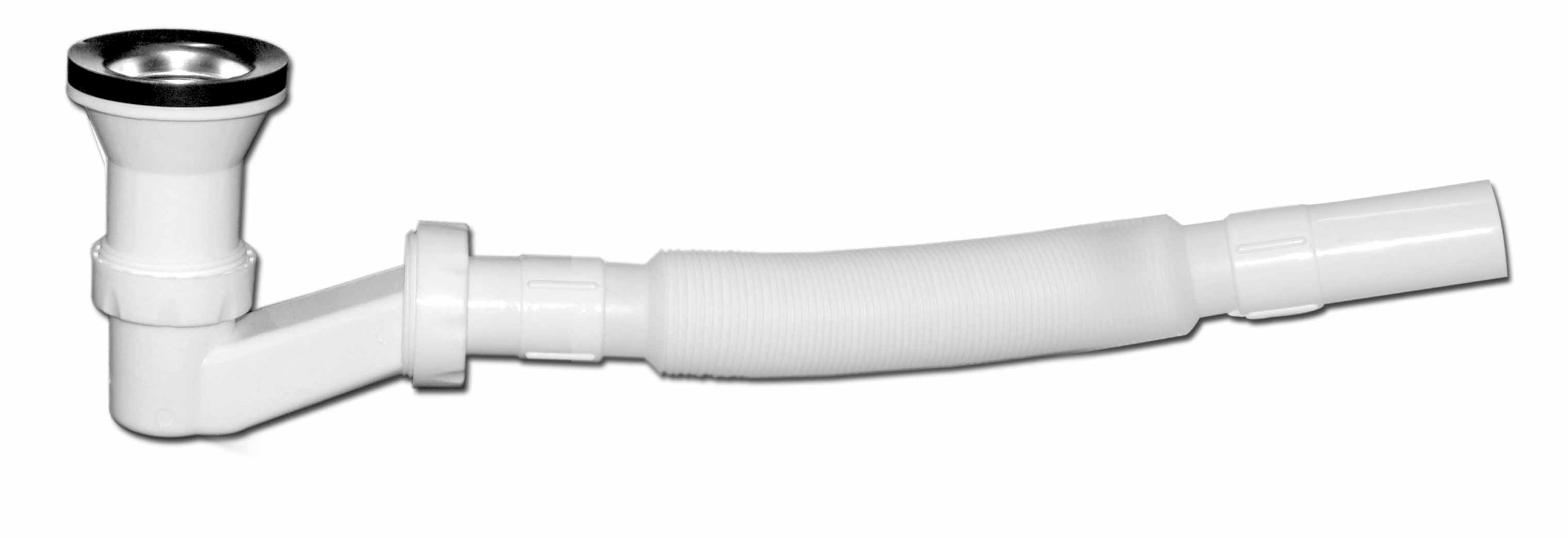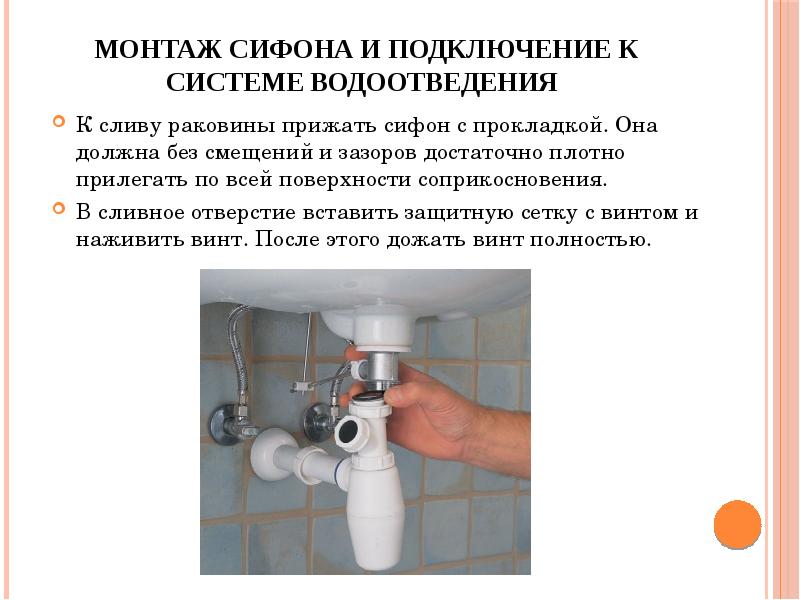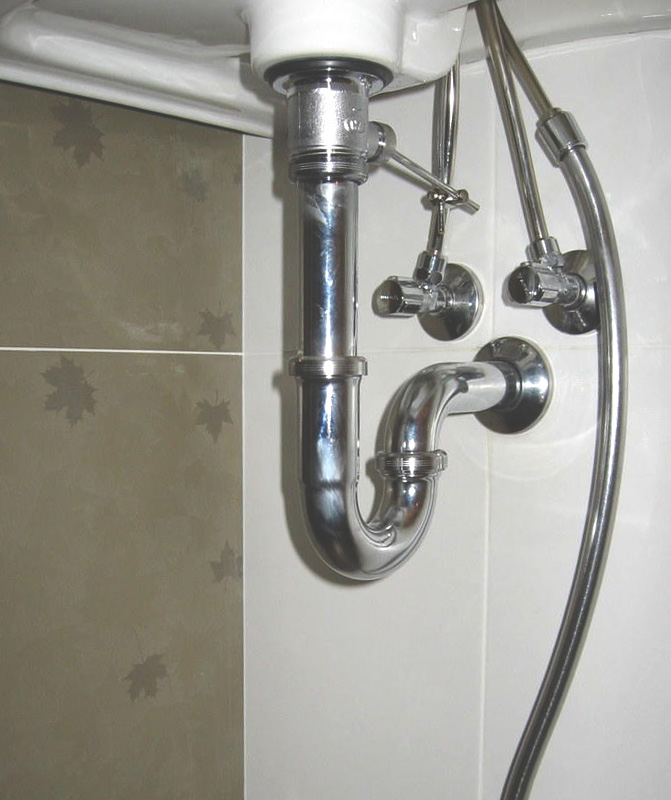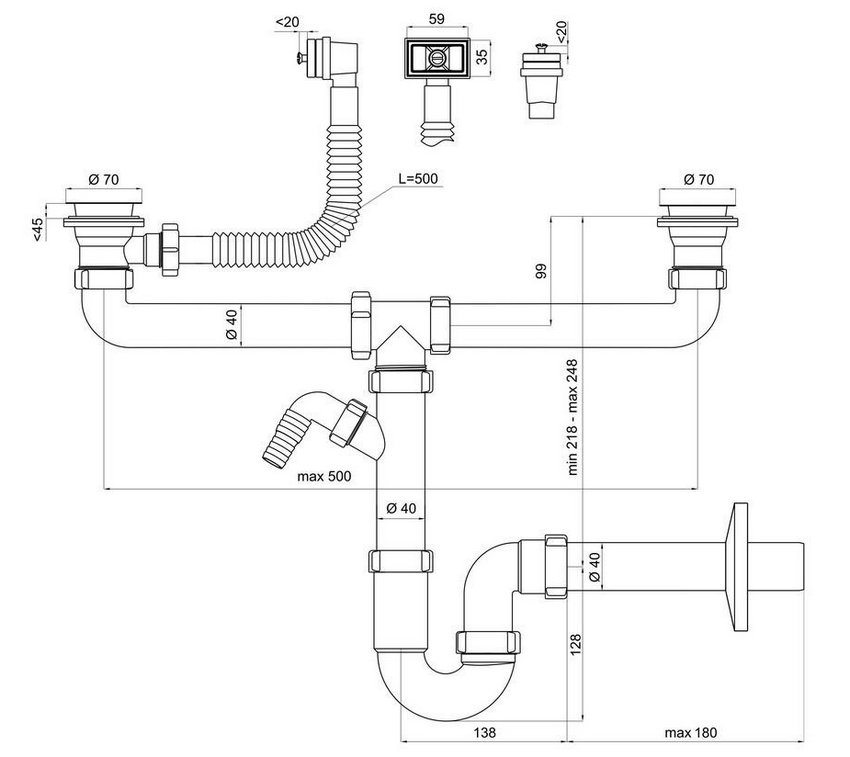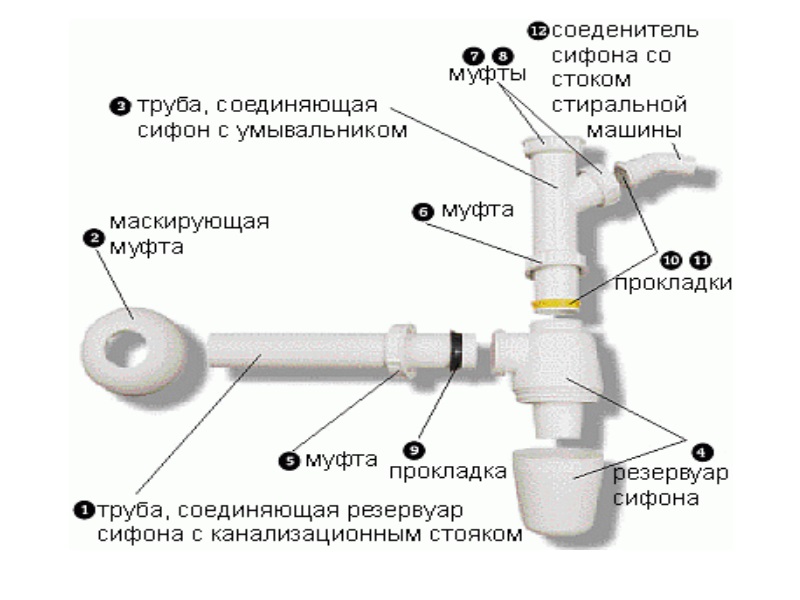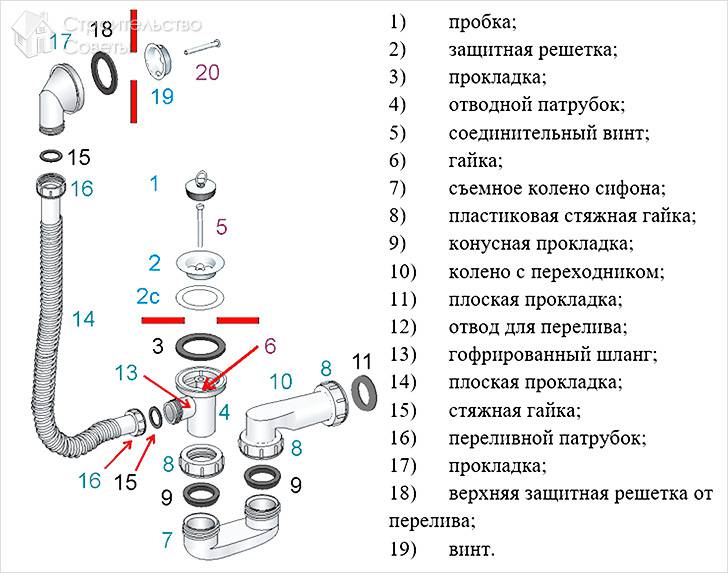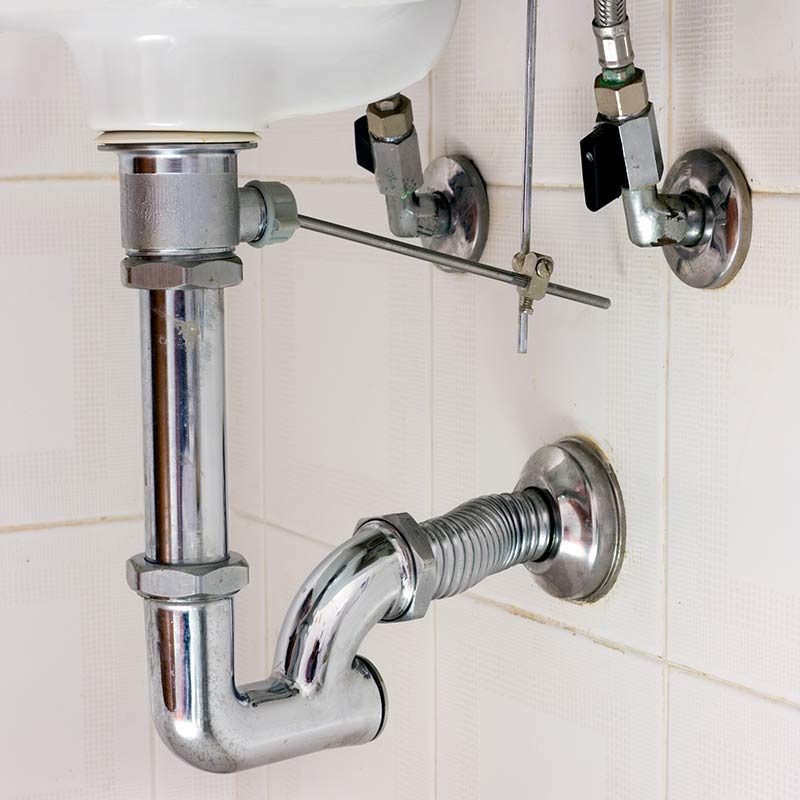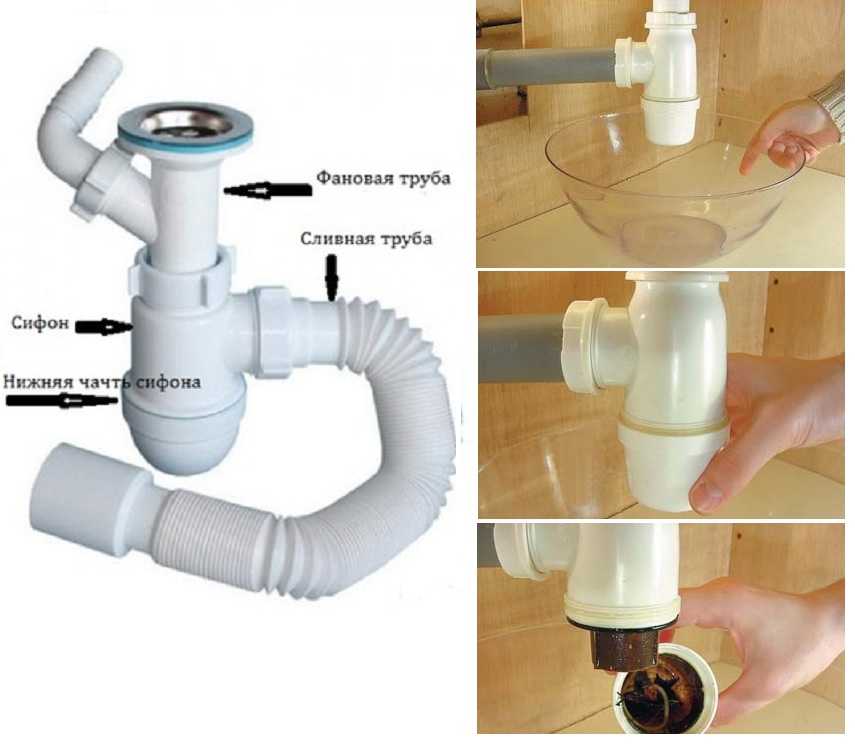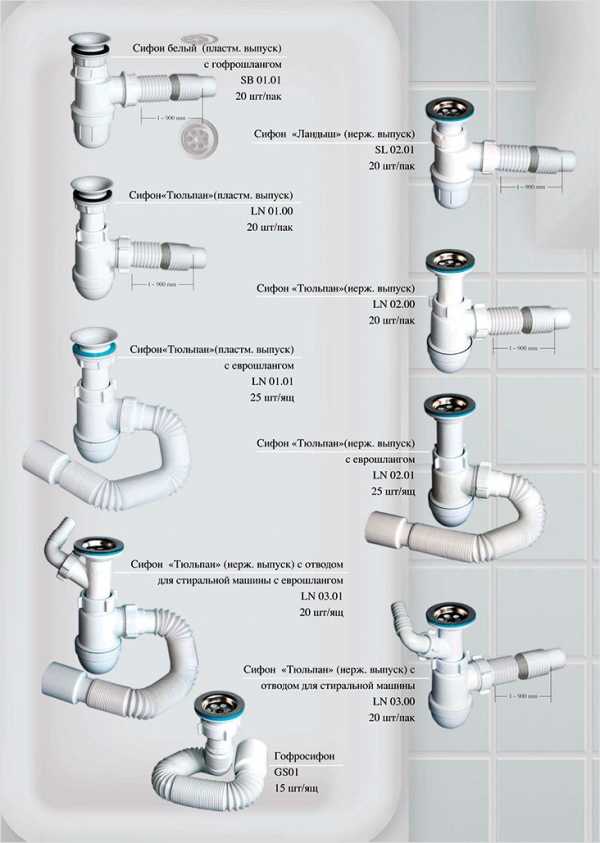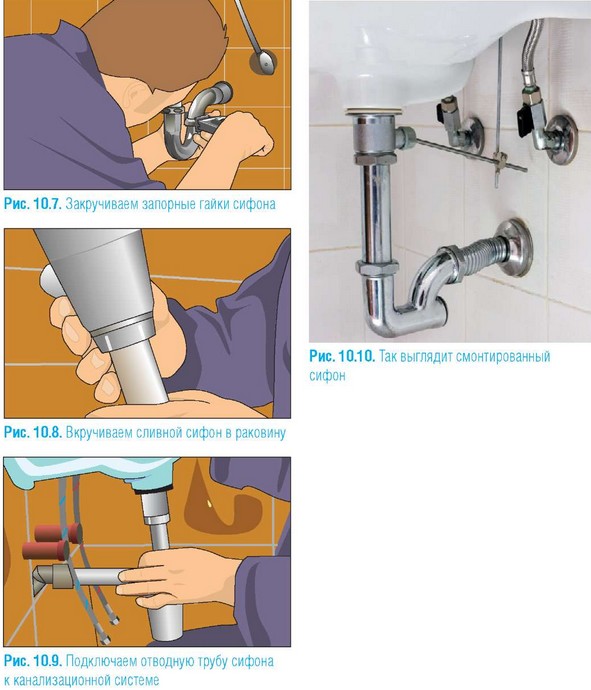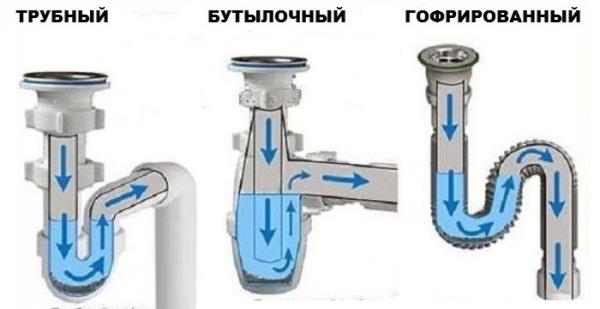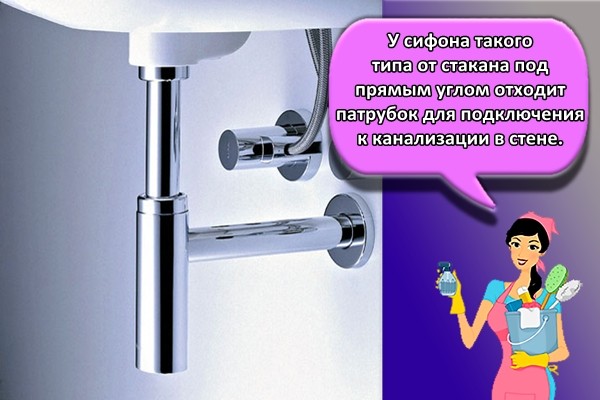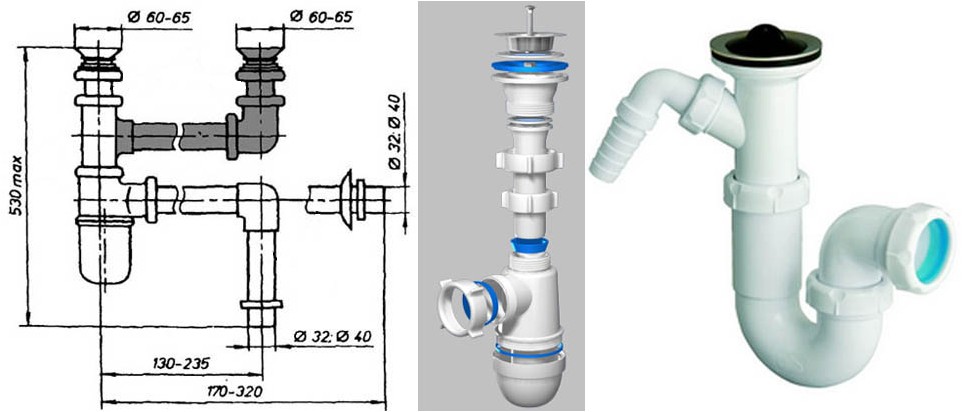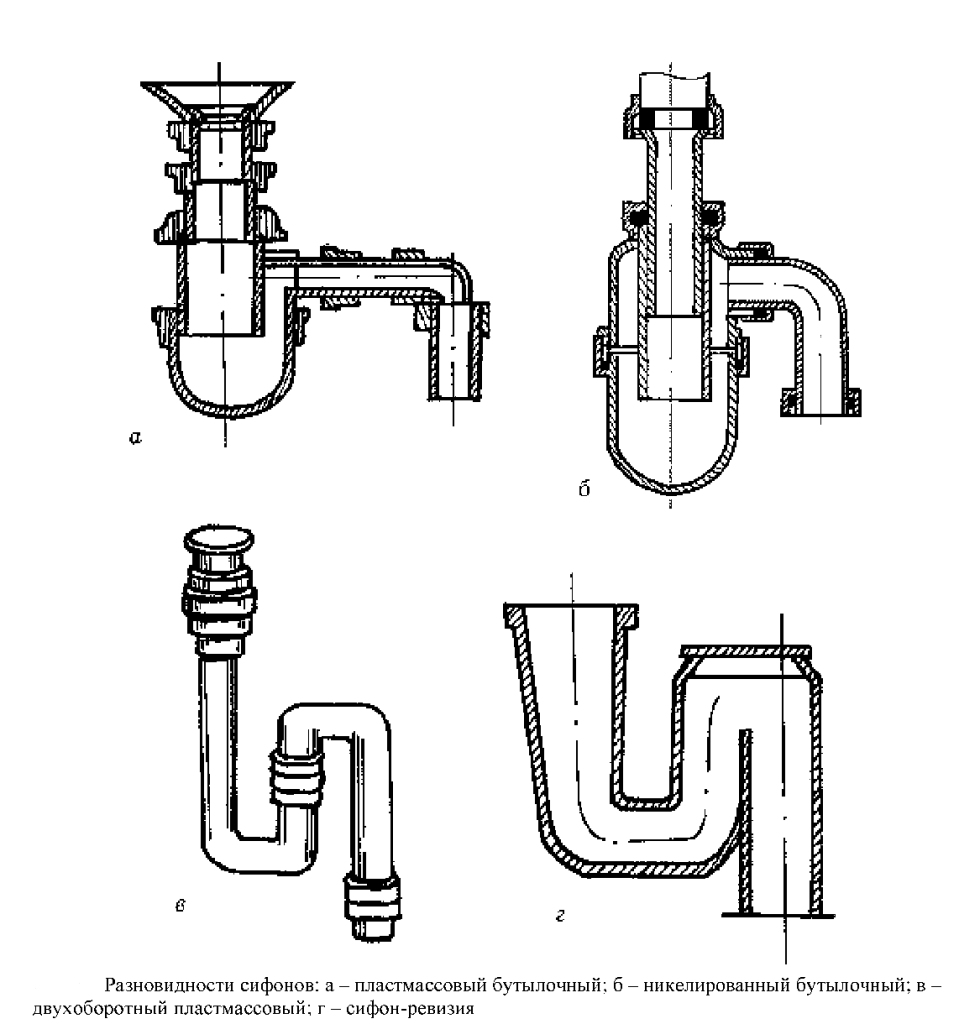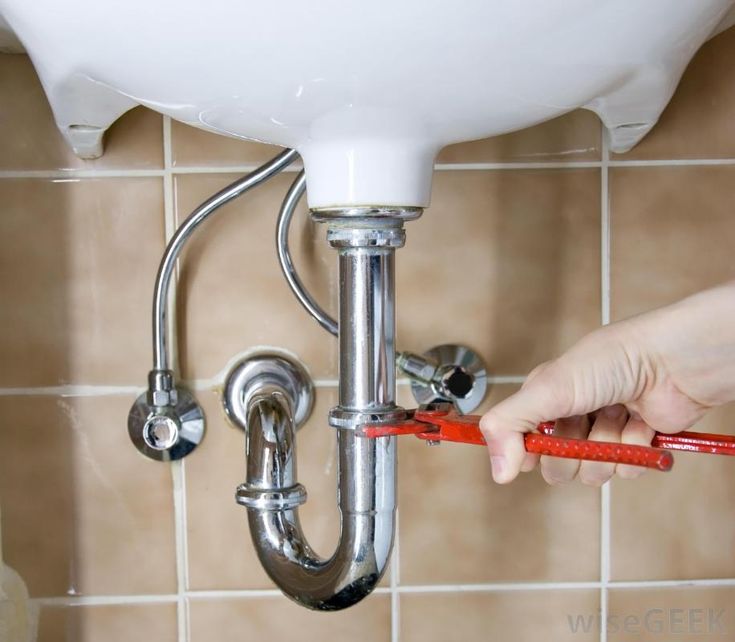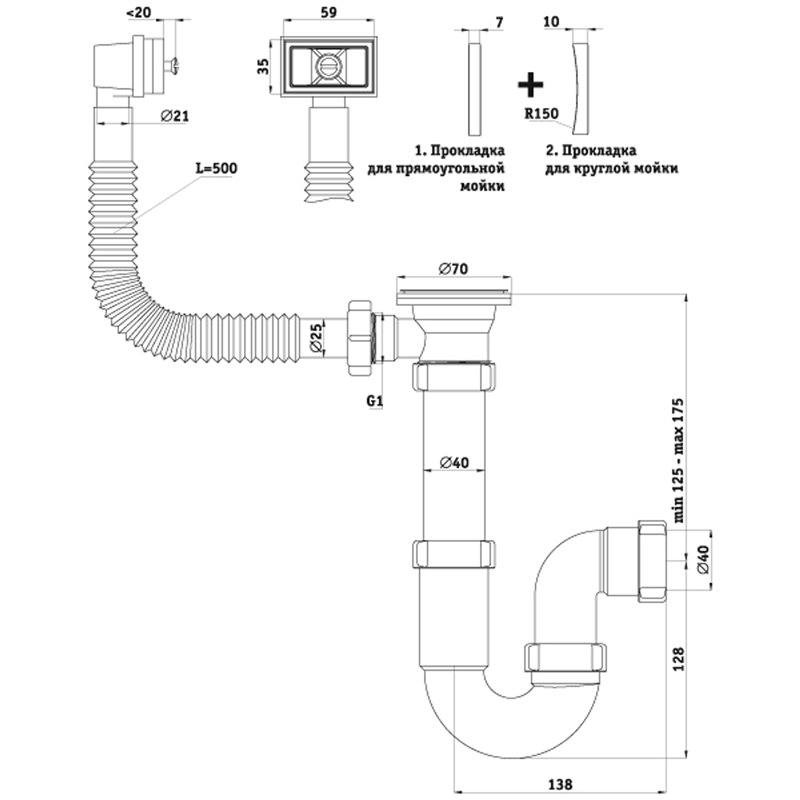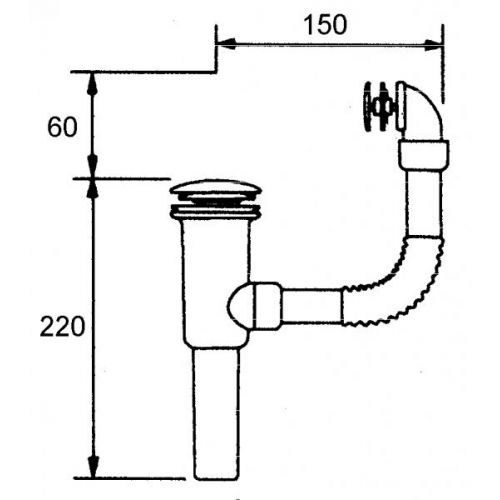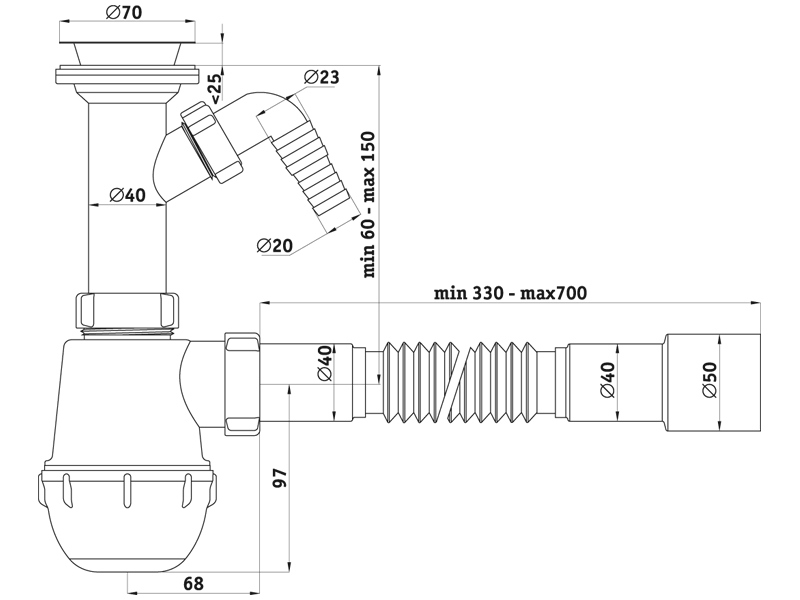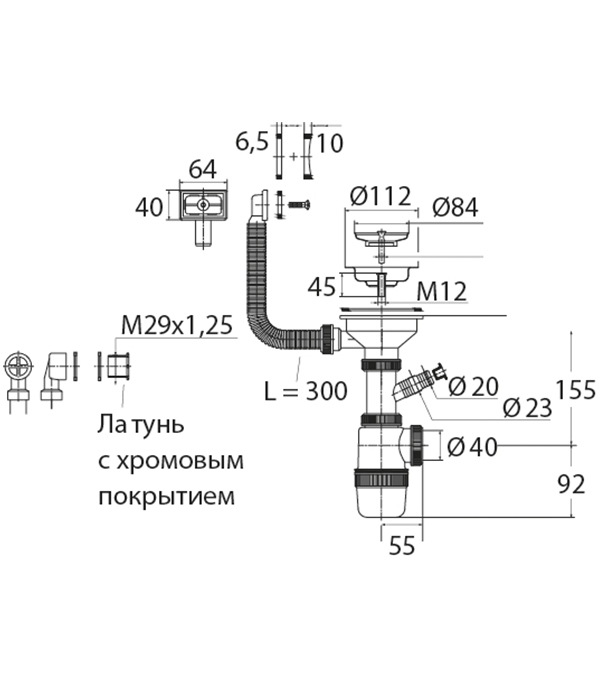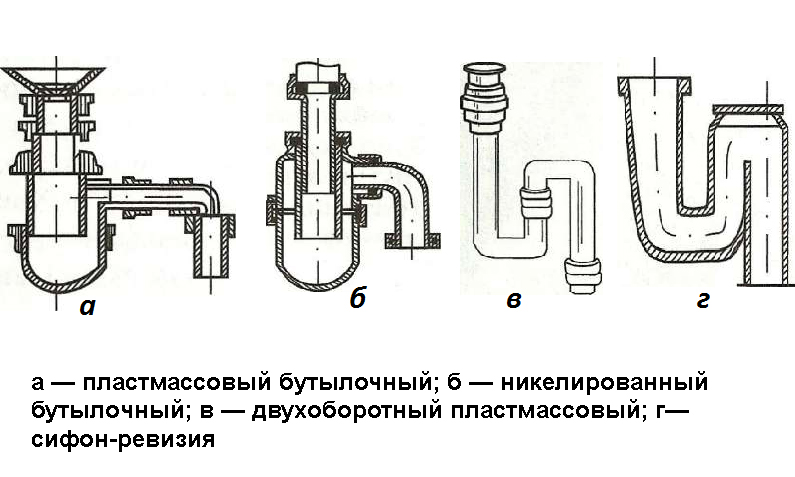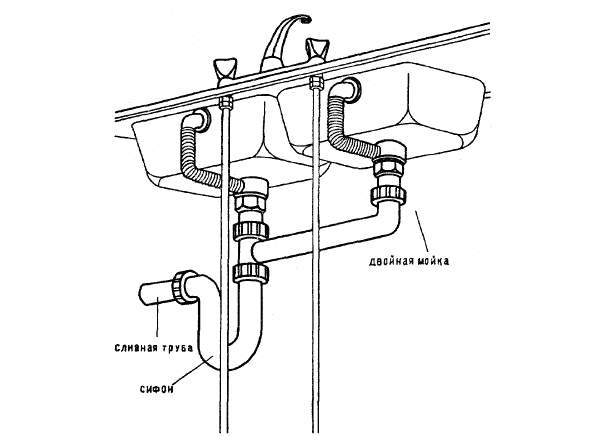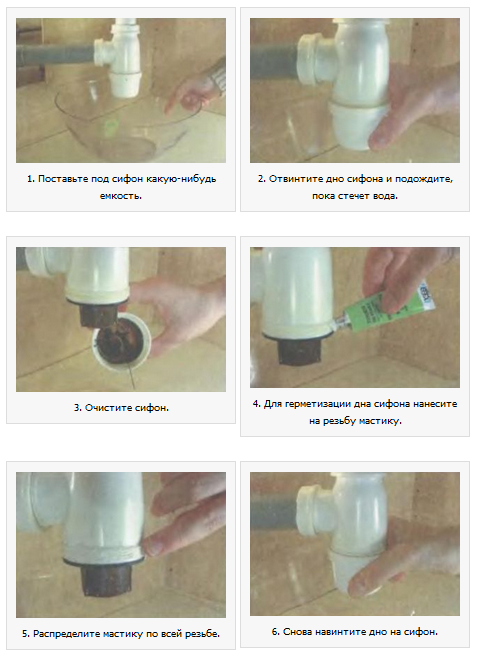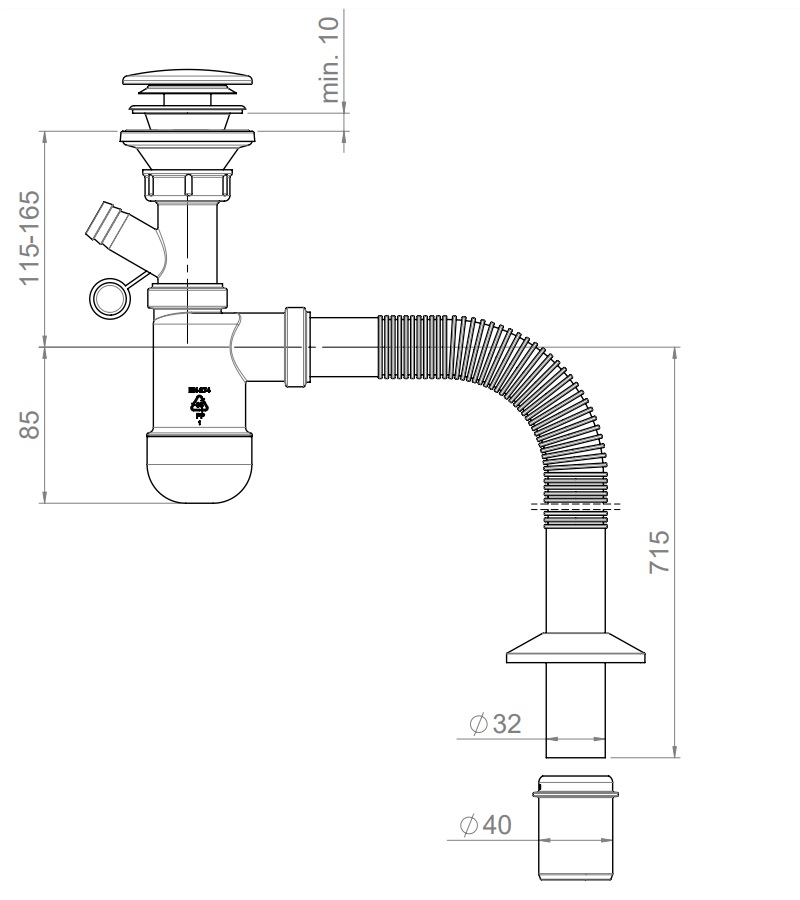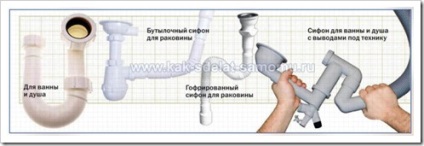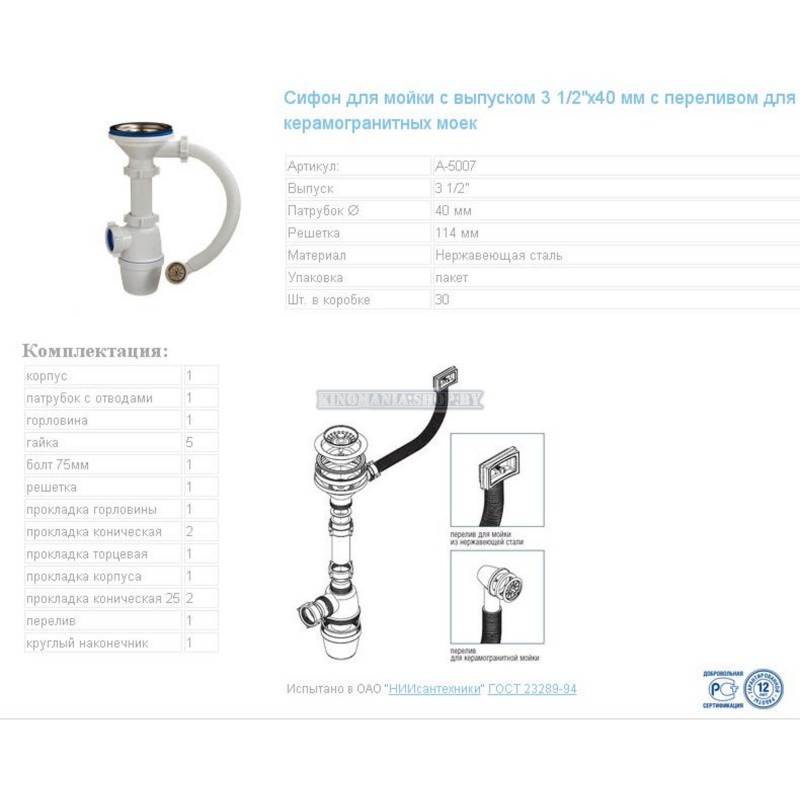How to choose the right product?
in the drainage system, each device is connected independently.Therefore, when choosing a weir, it is important to consider which plumbing unit it will be connected to. As mentioned above, each device has its own siphon;
you will have to connect the drain with a sewer of a certain size, so you need to know the diameter of the hole
In addition, there are differences between domestic and foreign sanitary ware. When buying, it is better to immediately clarify this information with the seller;
free space plays an important role in the choice of design. If there is not enough space, you can use a corrugation that bends at any angle. And if there are empty squares under the sink, it is better to install a knee or a flask;
the connection of the drain to the pipe must be made of plastic. This material is non-corrosive, easy to install and has a long service life.
Assembling siphons under the sink in the kitchen of Ani plast and Ani grotto
Siphons of domestic production of the brands Ani plast and Ani grot belong to the class of inexpensive but high-quality sanitary products. Due to their attractive appearance, excellent performance characteristics, high quality workmanship and low cost, they are widely used in the Russian market.
Video - The sequence of actions when assembling the siphon brand "Ani grot"
Domestic manufacturers of drain fittings offer consumers various models of siphons. Their assembly and installation is carried out according to the general principle:
- upon purchase, the complete set of the product is checked;
- according to the diagram attached to the instructions, the device is assembled;
- the installation begins with the connection of the siphon inlet to the sink;
- then the main unit is assembled;
- the drain pipe is connected to the sewer system;
- at the final stage, the tightness of the connections is checked.
Video - Assembling the siphon for the sink "Ani plast"
In conclusion, we note that a properly assembled siphon will work flawlessly for a long time. The service life of the plumbing fixture increases with the observance of the operating rules, regular cleaning from contamination and the timely replacement of worn out gaskets.
We recommend that you pay attention to the article - How to embed a sink into a worktop, which describes in detail how to install a sink with your own hands
Kitchen sink prices
Kitchen sink
The assembly of the siphon is not particularly difficult, carefully and carefully following the manipulations recommended by the instructions, even an inexperienced person in plumbing will cope with the work. Nevertheless, with complete uncertainty in one's abilities, it is better to turn to specialists, since the installation of any plumbing fixture is a very responsible matter.
Siphon installation rules
In order for the purchased siphon to function correctly, it must be assembled in accordance with the requirements specified in the instructions.
The sequence of assembling the structure is as follows:
- A large flat gasket should be placed on the large hole in the main tube and the existing cap screwed on the side.
- It is necessary to screw a union nut onto the branch pipe, and on top of it a conical gasket. Then the assembled structure must be inserted into the upper hole and screwed tightly without pinching it.
- In the event that a siphon with an overflow is being assembled, it is necessary to connect this part with a branch pipe outlet. To do this, you first need to put a nut on the outlet, and on top of it - an annular gasket. Next, the assembled structure must be connected to the overflow, placing it with a blunt end to it and tightening it with a nut. In the event that an overflow is not provided in the siphon design, this assembly stage should be skipped.
- At the final stage of assembly, you should take a corrugated pipe and carefully put a union nut on it, and on top of it - a cone-type gasket. After that, the pipe must be screwed to the siphon, thereby completing the assembly process.
In order to install the assembled siphon directly into the sink, you must follow the following recommendations:
- First of all, place the O-ring on the pipe, with the strips facing up. The second ring included in the kit should be pulled over a metal mesh, which should then be placed over the sink.
- Next, you need to adjust the siphon to the drain hole in the sink.
- Screw the screw into the grille.
- Using the rigid tube that comes with the siphon, you need to connect the assembled structure to the sewer. It should be noted that at this stage, the process is much faster for the corrugated pipe.
- At the final stage, it is necessary to let water through the siphon, checking the tightness and correct installation.
How to care for the siphon?
Any kind of sink drain needs regular maintenance. It consists in inspection for damage, high-quality cleaning of the product and careful removal of the resulting blockages.
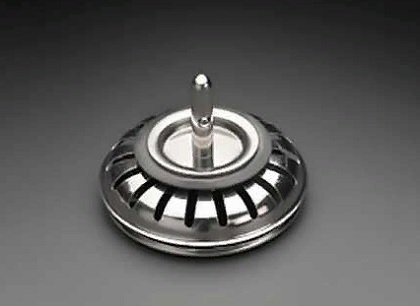
Careful operation of the sink, the use of special protective grids or food grinders increase the interval between cleanings, but anyway, sooner or later, such a need arises.
The complexity of the procedure is determined by the material and design. Corrugated siphons are cleaned only after complete disassembly; in bottle siphons, it is enough to unscrew and rinse the flask.
Some devices are easily pierced with a special tube. For the purpose of cleaning, use chemicals such as "Ruff", "Phlox"
They should be used with caution, especially for plastic models.
To prevent the siphon from clogging up so much, you can periodically spill it with hot water with the addition of a handful of citric acid.
It is also worth paying attention to the fact of rapid wear of the rubber seals. It is best to try to replace them approximately every six months.
Recommendations for choosing a sink siphon
When deciding on a siphon for a washbasin, it is necessary to take into account the following points:
The type of sink structure under which the branch pipe will be placed. If there is enough free space, then it is better to prefer more reliable metal siphons. In addition, they have excellent external data. As for plastic models, they should be used exclusively in closed structures.
Room area. The best option for small bathrooms is corrugated siphons. In addition to being compact, this type of product has good flexibility. This makes it possible to install them in narrow niches next to the washing machine.
It is recommended to equip country houses with non-permanent residence with so-called "Dry" siphons. The absence of moisture inside such a structure makes it possible to painlessly tolerate a drop in air temperature to minus values.
Throughput characteristics
It is important to calculate that the pipe is able to pass the entire volume of treated water through it. This is especially true for those situations when household appliances are directly commuted to it.
How to fix it?
One of the reasons why you have to change the siphon is when water begins to drip from the bowl, the hose itself flows, or you hear something gurgling. In this case, it is necessary to check the tightness of the connections, which may be violated due to the outcome of the service of the repair kit. In some cases, it is possible to dismantle the siphon with your own hands, in particular, if it is entirely plastic, if there is a siphon made of a more expensive material like brass, non-ferrous metal, you should seek specialized help.
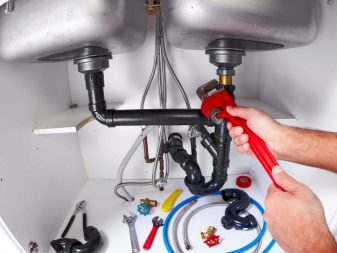

To disassemble parts, you need to know a few points:
- in the sewage system, the pressure corresponds to atmospheric, due to which it will be easy to disassemble the siphon, especially if it is plastic;
- it is necessary to prepare a bucket and rags to collect liquid from the pipes, which will spill if you unscrew all the elements of the siphon;
- stop the water supply and disassemble the siphon;
- all parts must be cleaned if they are still suitable for further work;
- depending on the cause, it is necessary to eliminate the problem, and this may be: changing the repair kit, removing blockages, cleaning parts, eliminating cracks in the pipe (using glue and cloth), sealing joints, etc.
- if it is no longer possible to repair it, it is worth buying a new siphon; when assembling at home, you need to be guided by the drawing that is attached to the siphon, and already connect it to the sewer according to the scheme.


Popular manufacturers
The top ten popular manufacturers of siphons and plumbing devices include:
- Viega;
- Orio;
- AlcaPlast;
- MCAlpine;
- HL;
- Geberit;
- Blanco;
- Wirquin;
- Suntek
The first manufacturer from the list from Germany is engaged in the production and sale of various engineering equipment. The assortment is extensive - about 17 thousand items. The products have been nominated and awarded more than once in the field of design and technology.
- Viega siphons are not only a premium class, but also ordinary budget models that are of high quality. The second from the list is a domestic manufacturer supplying low-cost product options to the market. The products are environmentally friendly and have a long service life. The assortment of products is large and varied.
- AlcaPlast is a Czech brand known on the market since the 90s. The range of branded products is small, but the main criteria of the company are design and quality. The latest innovations meet the criteria of manufacturability and are equipped with modern automation. MCAlpine manufactures a wide range of plumbing fixtures and fittings. The firm is English, has an extensive dealer network around the world. The products are one of the most counterfeited among other competitors. Manufacturers even offer a memo to buyers, according to which the original can be distinguished even by its packaging.
- Hutterer & Lechner branded products are presented on the market as innovative. It is believed that individual plumbing units can be combined with different pieces of equipment, all parts are interchangeable. Installation of many models is convenient thanks to special hinge mechanisms.
- Geberit is a Swiss company specializing in the production of plumbing fixtures and sewerage systems. The devices are characterized by increased attractiveness and reliability.
- Blanco is another German manufacturer on this list. The company supplies the market with various models from the most budgetary to the most expensive. The range of models is very diverse. At the same time, one type of siphons on the market can be made of different materials. The buyer is immediately given the opportunity to compare products.
- Wirquin is a French company that offers customers a variety of products. The company unites several factories located in different countries. The main product criteria are reliability and quality.
- Suntek is a Russian manufacturer that offers inexpensive devices for various types of plumbing fixtures. The company manufactures its products from plastic, all products have a 10-year warranty.
- Jimten is an Italian company known in the world market for many years. Italian plumbing has long been synonymous with quality, and Jimten only confirms the statement.
What materials are the devices made of?
Various types of raw materials are used in the production of siphons. Each of them has its own advantages and disadvantages.
When choosing the right device, it is important to make sure that the material from which it is made is strong enough to resist corrosion and oxidation.Its service life depends on these characteristics.
Available plastic products
Plastic siphons are the cheapest and most common devices with a simple design and few connections.
Devices are made from PVC, polyethylene, polypropylene. The latter option is preferable because it lasts longer, has better strength and is less sensitive to high temperatures.
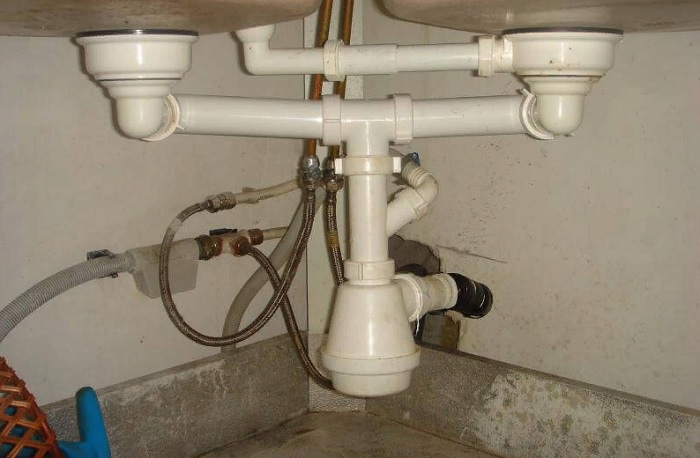
The range of PVC products includes advanced branched models designed for two-section sinks and side-by-side sinks
Due to the smooth and even inner surface, impurities contained in the water do not accumulate on the walls. Some manufacturers apply antibacterial coatings to the cavity to prevent excessive accumulation of dirt and grease.
Plastic products are very flexible. Most of them are equipped with flexible corrugation outlets, which quickly take the shape required for installation.
Durable metal devices
In the manufacture of metal products, brass, bronze, copper, and chrome plating are used. They stand out for their stylish design that perfectly complements luxury interiors.
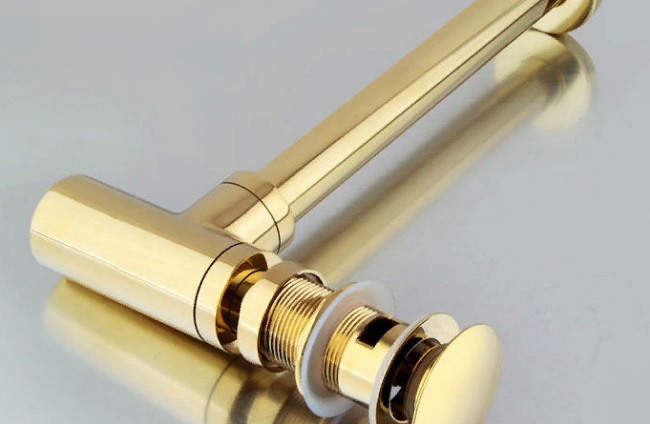
High-tech bronze products look impressive and stylish, but they are not entirely practical for the kitchen. They are more often chosen for bathrooms.
It should be borne in mind that pipes made of metals require precise adjustment of the dimensions during installation, they are difficult to shorten, and maintaining the original appearance takes a lot of time and effort.
Such devices are more appropriate in bathrooms, where they will be visible, performing a decorative function.
Principle of operation
The classic siphon is a curved pipe, the elbows of which differ in different lengths. Water from the vessel located above enters the vessel below. For performance, the level of the liquid matters. Therefore, it must first be filled with water. The physical properties of a liquid substance underlie the principle of the siphon. Water is constantly at the bottom of the curved outlet of the appliance. Due to the curved shape, pressure is maintained inside. The drains are renewed, thereby preventing the entry of unpleasant odors into the room. Waste water flows into the siphon every time it is used.
For example, from a sink, liquid flows into the outlet of the structure. Then the water flows into the bottle and leaves through the connecting branches. Then the liquid enters the outlet compartment, and from here into the sewer pipes.
The siphon design includes:
- outer part;
- insulating socket;
- branch connecting to the sewer;
- sewage sump;
- sealing gasket;
- corner gasket;
- filter grate;
- connecting screw.
Structurally, siphons may differ, but the devices have an identical purpose. In addition to the design, the materials that the manufacturer uses in production may vary.
Device and principle of operation
Regardless of the design, any drain works on the principle of communicating vessels, it has an inlet pipe that receives water from the sink, located above, and a drain pipe that leads water to the sewer, located below the inlet.
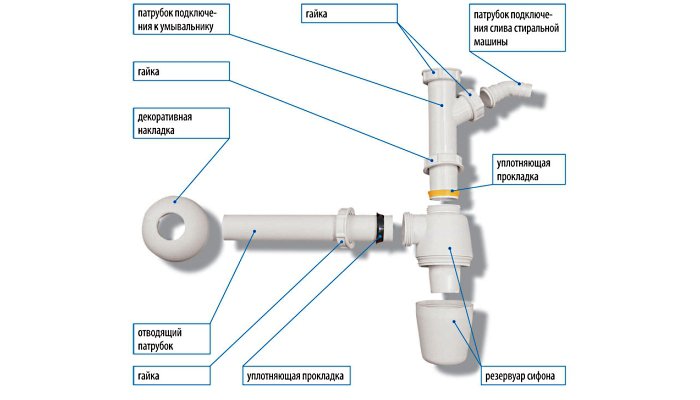
Between them there is a section where there is always water. This is the so-called water lock, or a water seal, which serves as a barrier against the penetration of odors from the sewer through pipes into the living space.
In the same part, most of the contaminants and household waste that enter the drain are retained, they can be removed when cleaning the drain, this is much easier than cleaning the sewer.
In pipe models, the water seal is located in the bend of the pipe, in bottle models - in a glass, under a submerged pipe and around it under the lower diagonal partition. While water is flowing out of the sink, pressure builds up in the drain and the water is forced down the drain.
When all the water from the sink has drained out, and the tap is closed, the pressure stabilizes, the water cannot independently overcome the bend or leave the flask and remains at the lowest point, forming a water seal.
In flat drains, as well as corrugated pipes with a slight bend, the volume of the water plug is minimal, if the sink is not used for a long time (the owners are away), this water can completely evaporate and the barrier to odors disappears.
Siphon assembly diagram for kitchen sinks - step by step instructions
The siphon is assembled according to the attached instructions with a detailed diagram.
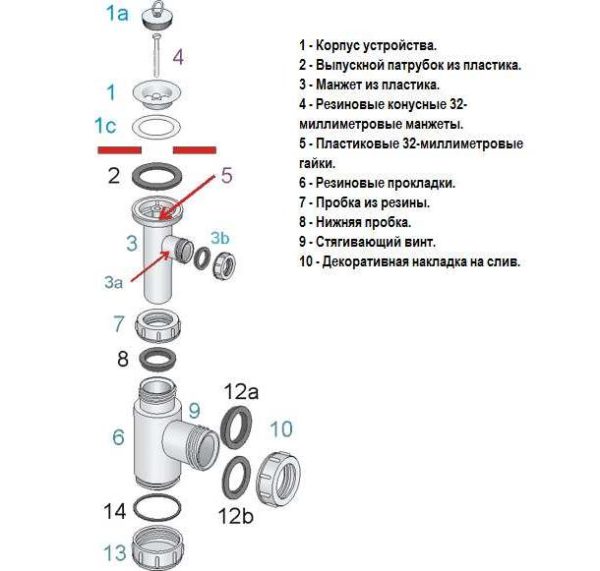 Siphon assembly diagram
Siphon assembly diagram
Step-by-step sequence of actions
Step 1. Connection to the sink. The inlet is connected to the sink as follows:
- a protective mesh (1) with a sealing gasket (1c) is placed on the sink drain;
- a gasket (2) is installed on the tide of the inlet pipe (3);
- with a screw (4), the protective mesh is attached to the inlet.
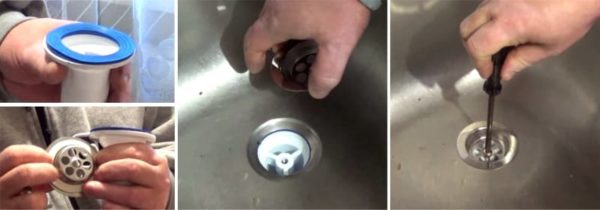 We attach a protective mesh
We attach a protective mesh
Step 2. Installation of the main part of the device. To assemble the main part of the siphon, the following manipulations are performed:
- the sealing gasket (8) and the fastening nut (7) are placed on the lower part of the inlet pipe;
- the branch pipe is inserted into the body (6) and the connection is strengthened by turning the nut down;
- the cover with gasket (14) is screwed to the siphon body (13).
 Establishing the base
Establishing the base
Step 3. Connection to the sewerage system. To connect to the sewer, you must:
- install a sealing gasket (12a) on the outlet pipe (9);
- fasten the connection of the branch pipe with the sewerage pipeline by tightening the nut (10).
 We connect the outlet pipe to the sewer
We connect the outlet pipe to the sewer
You need to talk in more detail about docking with sewage. The diameter of the siphon outlet is most often 40 or 50 mm. If the diameter of the sewer pipe is also 50 mm, it will be enough to use a seal for the connection. In the event of a mismatch in size, transitional rubber cuffs are used.
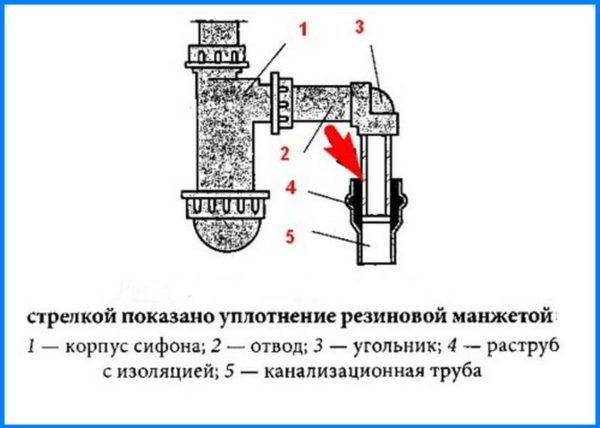 Sealing the connection to the sewer pipe with a rubber sleeve
Sealing the connection to the sewer pipe with a rubber sleeve
The most important thing in the assembly process is to create connections with maximum tightness. Sealing gaskets in the seats are fixed with silicone or other moisture-resistant sealant, the threaded fasteners are screwed in until they stop. After completing the work, remove the excess sealing material protruding at the edges of the joints.
Which siphon is suitable for a bidet
Siphon systems currently used when installing a plumbing fixture such as a bidet can have the following configuration:
- tubular siphons resembling the letter S in their appearance;
- bottle siphons, similar in shape to a traditional bottle.
The first version of the siphon system has a more complex design, but both types include several basic elements, therefore, the device is assembled before installation.

Siphon option for bidet
As the practice of operating a plumbing fixture shows, bottle-type models are more ergonomic and profitable, due to their special shape. In the bottom part of such a siphon, things that accidentally fall into the drain hole are collected.
Depending on the material used in the production of siphons, such an element can be represented:
- plastic models;
- brass models;
- steel models.
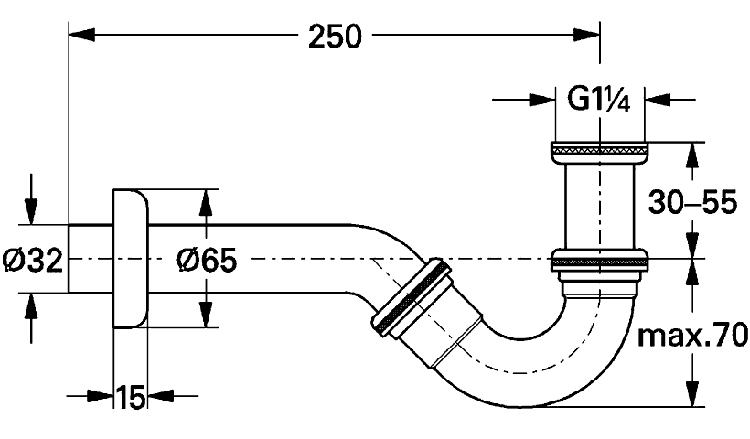
Bidet siphon Grohe
Plastic siphons are more preferable for performing concealed installation of sewer communications, which is due to their functionality and guaranteed durability.
The higher cost characterizes bottle siphons made of metal. It is these devices that are distinguished by their visual appeal and ease of use.
Useful Tips

- It is better to choose systems with a smooth-walled pipe that is discharged into the sewer, they are easier to clean.
- From the moment of dismantling the old siphon and until the last stage of installing the new sewer bell, it is advisable to plug it with a rag or plug of a suitable diameter.
- The surface of the sink around the drain hole must be thoroughly cleaned and degreased.
- All threaded connections are sealed, except for the thread of the flask cover - it will have to be unscrewed from time to time; tow can be used to prevent leaks.
- In flask-shaped models with a submerged tube, the height of the flask can be adjusted by immersing the branch pipe into it to different depths, but it should not touch the bottom, fixation at the extreme upper point is also undesirable.
- It is better to purchase a siphon with such connecting dimensions that the diameter of the sewer pipe corresponds to the diameter of the sewer pipe.
There are other options - buying a siphon with a universal, stepped drainage system and cutting the branch pipe until the desired diameter is obtained, or using a transitional sealing collar. The first option is safer.
You need to buy a sink for washing either at the same time as it, or after, taking into account its design, structural features.
A modern sink for a kitchen sink is easy enough to install without the help of specialists. The main thing is to choose a model suitable for specific conditions, make sure that there are no defects and follow the instructions.
There are a significant number of models on the modern market, and the installation of each of them has its own nuances, although the general principles are the same for all types and varieties of drains.
Varieties of siphons
Before starting the main work, you should decide on a suitable type of siphon for the kitchen. There are the following types of siphons for kitchen sinks:
- A pipe siphon is a flexible, rigid pipe that forms a water lock. Some types of pipe siphons have a convenient sleeve on the underside that can be opened for cleaning. When choosing such a siphon for the kitchen, you should correctly connect the sink drain and the inlet to the sewer. To clean it, you do not need to dismantle the siphon: you just need to remove the lower elbow. Pipe siphons are in demand because they take up a minimum of space and have a nice appearance. But they will have to be cleaned quite often, besides, with infrequent use, a small size of the water seal will lead to the evaporation of water and the appearance of a persistent odor;
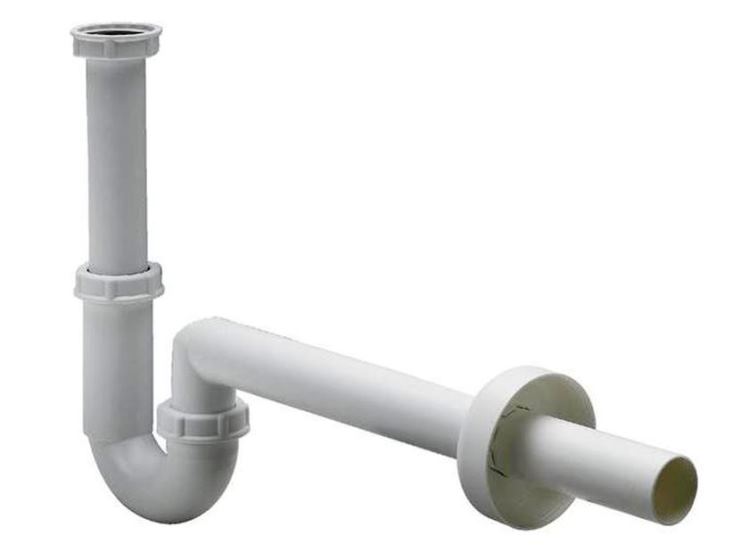
you can choose a bottle siphon for your kitchen sink. It is he who is used most often. This siphon is shaped like a bottle where the water seal is located. The connection to the sewer is provided with a straight or flexible tube. The advantages include the price of this type of siphon, as well as the small size and ease of removal. But in the area where the flow is removed from the bowl of such a siphon, debris quickly accumulates, so do not forget to clean it;

corrugated kitchen siphon is the third type. It is a flexible material that will simply be given the desired trajectory and slope. Thanks to the special design of such a model, you can connect the sink with the entrances to a non-standard sewage system. This siphon is mounted very simply and does not cause any difficulties in work. And due to the fact that there are no intermediate fixtures in it, you can not worry about possible water leaks. But the corrugated model also has disadvantages: for example, in order to clean out the blockages, you will have to completely remove the siphon.
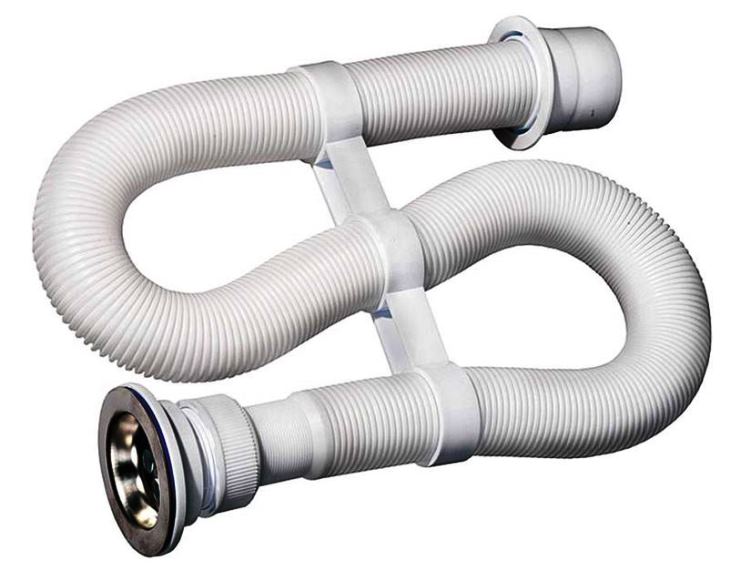
Attention! There is also a hidden type of siphon, which is the shape of a flask installed in the wall. It has a high cost, but it helps to mask communications and perfectly saves free space.
The flask systems are easy to clean as they can be unscrewed and quickly discarded.
Some bottle models have a branch pipe mounted in the flask. They are much easier to install in the kitchen.Many people prefer to use smooth pipes connected to the sewer system, since they are easier to clean from dirt.
Such components may differ in other characteristics. For example, you can install a siphon for a double kitchen sink or for a triple sink.
The main difference between the siphon for a double sink is the presence of two connections to its base, which go into one sewer drain. Of course, the cost of a siphon for a kitchen sink with two bowls will be more expensive. What a siphon looks like for two sinks, look at the photo.
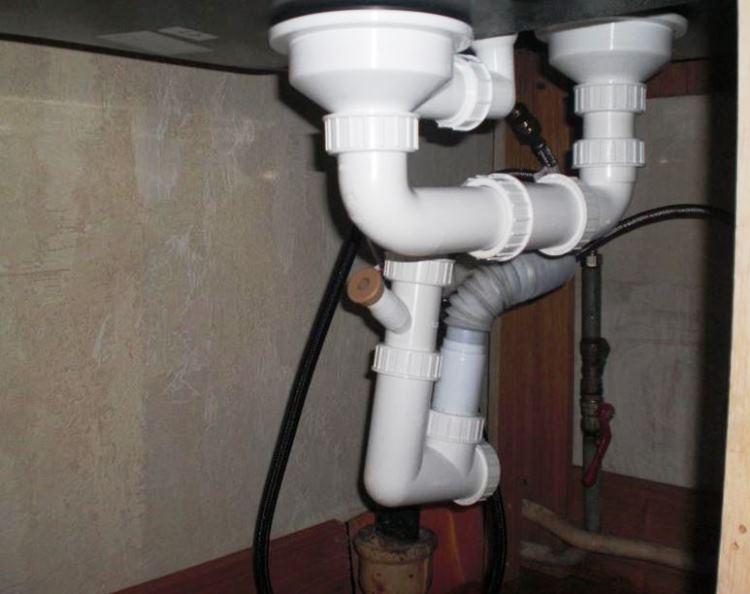
There are also models of a flat siphon for kitchen sinks. It is used if the space under the drain is limited. Another type is a siphon for a kitchen sink with an overflow. Overflow is a pipe through which water will flow out when a certain level in the sink is reached. This design will prevent accidental overflow of water beyond the boundaries of the kitchen sink.
When installing a siphon in the kitchen, one more feature should be taken into account, namely, the size of kitchen siphons, since there are several variations of such devices. Focus on the size of the drain and sewer holes, as well as the availability of free space under the sink.
Of course, which siphon is better for the kitchen cannot be said unequivocally. Therefore, it would be more correct if, before buying a siphon for a kitchen sink, you familiarize yourself with the available possibilities, study their structure, and also understand the nuances of installation, which we will discuss further.
What material is the siphon made of for the sink
There are different types of such plumbing devices:
- plastic;
- metal.
The first of the options is found in 2 types: polypropylene, polyethylene.
Left - metal chrome, right - plastic sink siphon.
These materials are not inferior in properties to metal counterparts, but differ in a number of advantages, due to which their prevalence has increased:
- smooth inner walls of plastic pipes, which does not allow dirt to linger inside the communications, as a result, plugs are not formed;
- minimum weight, due to this, no additional load is created on the sink;
- there is no likelihood of corrosion development;
- due to the fact that dirt does not collect inside, the decay process does not develop;
- plastic models of siphons serve for a long time, since they can withstand temperature extremes, the effect of their high values;
- low price.
The brass sink siphon does not corrode.
In addition, when using this type of water seal, it becomes possible to quickly make repairs or install a new plumbing fixture. This is due to the simplicity of dismantling and installation.
The siphon is disassembled and assembled as a constructor, it is only important to observe the sequence when connecting the elements. In addition, if a leak occurs, the plastic nut can be easily tightened.
There is also the possibility of replacing individual elements of the design of the plumbing device. You just need to purchase a part that will be installed instead of the damaged one. They are interchangeable, since the dimensions of the pipes and pipes connected to the sewage system are in most cases the same.
There are also metal options:
- bronze;
- brass;
- made of stainless steel;
- chromium-plated.
The first 2 options are more common. They are less susceptible to corrosion. The advantages include long service life, strength, oxidation resistance. However, dirt accumulates on the inner walls of the water seal, which gradually forms into a plug, which first reduces the pipe lumen, and soon clogs it.
It is noted that the metal version makes the sink heavier. In addition, the installation cannot always be done independently. This is due to the fact that the principle of sealing metal and plastic elements is different.In the first case, fum tape, tow is used, and in the second, a rubber gasket is used.

